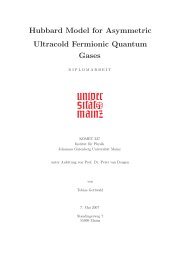5 Hirsch-Fye quantum Monte Carlo method for ... - komet 337
5 Hirsch-Fye quantum Monte Carlo method for ... - komet 337
5 Hirsch-Fye quantum Monte Carlo method for ... - komet 337
Create successful ePaper yourself
Turn your PDF publications into a flip-book with our unique Google optimized e-Paper software.
5.4 Nils Blümer<br />
initialization−→<br />
Σ 0<br />
Σ<br />
G<br />
k−int.<br />
Dyson eq.<br />
impurity problem<br />
G<br />
G<br />
(2) ←− DOS /tij /ενk<br />
(8)<br />
(3) ←− local interactions<br />
Fig. 1: DMFT self-consistency cycle in conventional <strong>for</strong>m: starting, e.g., with an initial guess<br />
<strong>for</strong> self-energyΣ, thekintegrated Dyson equation (2) yields the lattice Green functionG. Both<br />
Σ and G are used to compute the bath Green function G via (8) which defines the impurity<br />
problem (3). Its solution using QMC (or IPT, NCA, ED, NRG, etc.) provides a new estimate <strong>for</strong><br />
G. The cycle is then closed by application of (8) to the newGand the oldΣ.<br />
and the single-site action<br />
A[ψ,ψ ∗ � β�<br />
β<br />
,G] = dτdτ ′�<br />
0<br />
0<br />
σ<br />
ψ ∗ σ (τ)G−1<br />
σ (τ,τ′ )ψ σ (τ ′ ) − U<br />
�β<br />
0<br />
dτ ψ ∗ ↑ (τ)ψ↑ (τ)ψ∗ ↓ (τ)ψ↓ (τ) (7)<br />
Here, β = 1/kBT is the inverse temperature (in the following, we setkB ≡ 1) and<br />
G −1<br />
σn = G −1<br />
σn +Σσn<br />
is the effective local propagator. 3 Functions related by a Fourier trans<strong>for</strong>mation (here from<br />
imaginary timeτ to fermionic Matsubara frequenciesωn or vice versa) are denoted by the same<br />
symbol, but can be distinguished by their indices.<br />
The solution of the DMFT problem by iteration is illustrated in Fig. 1. Here, the solution of<br />
the k–integrated Dyson equation (2) is straight<strong>for</strong>ward; it can be per<strong>for</strong>med analytically <strong>for</strong><br />
the semi-elliptic Bethe DOS commonly used <strong>for</strong> model studies in the literature. In contrast,<br />
the solution of the impurity problem (3) is highly nontrivial. 4 Most numerical <strong>method</strong>s developed<br />
<strong>for</strong> the treatment of SIAMs with fixed bath could be adapted to the DMFT problem, e.g.,<br />
solutions based on exact diagonalization (ED) [1, 10], the non-crossing approximation (NCA)<br />
[11, 12, 13, 14], the fluctuation-exchange approximation (FLEX) [15, 16, 17], the numerical<br />
renormalization group (NRG) [18, 19, 20, 21], density-matrix renormalization group (DMRG)<br />
[22] and <strong>quantum</strong> <strong>Monte</strong> <strong>Carlo</strong> (QMC) algorithms. We will focus on the <strong>Hirsch</strong>-<strong>Fye</strong> QMC<br />
<strong>method</strong> in this lecture; recently developed diagrammatic continous-time QMC algorithms will<br />
be covered by Philipp Werner.<br />
3 Gσn may be regarded as a Weiss field in a (frequency-dependent) generalization of the usual static mean field.<br />
In contrast with spin models, <strong>for</strong> which the Weiss field replaces all (NN) interactions, the bath propagator replaces<br />
the hybridization of one site with the rest of the lattice.<br />
4 An exception is the application of (2) and (3) to a Lorentzian DOS ρ(ǫ) = t/(π(ǫ 2 + t 2 )) which can be<br />
realized on lattices with long range hopping [6]. For this DOS (which is clearly pathological due to its infinite<br />
variance), the Weiss function is independent of U; furthermore (3) is solvable by Bethe ansatz in this case so that<br />
many properties can be obtained analytically.<br />
(8)













